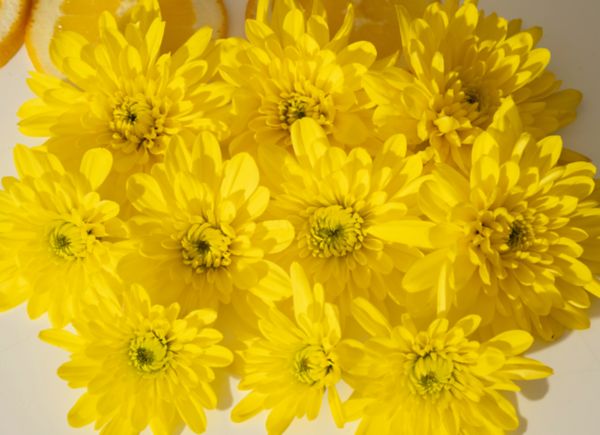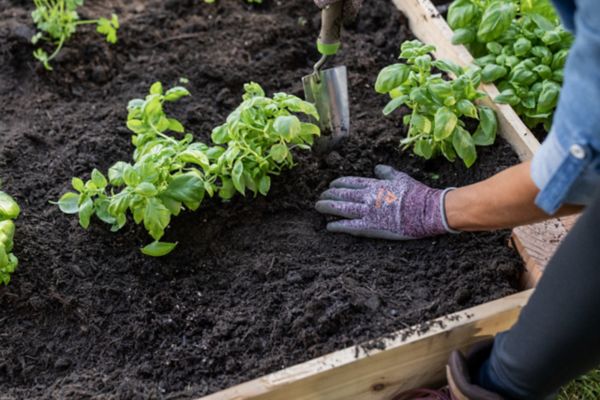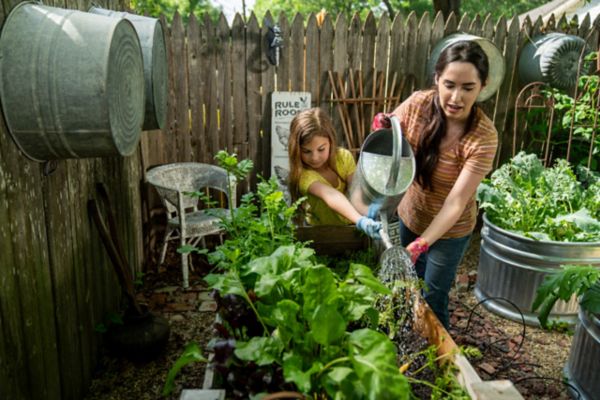How to Grow Dahlia
Authored by Leah Chester-Davis
Dahlias' vibrant and varied colors and long stems make them a popular cut flower.
Dahlias are striking flowers that are showstoppers in the garden. There are numerous varieties in a wide range of sizes and colors. Some types have blooms as small as an inch or two, and others have blooms as big as a dinner plate, growing to as much as 12 to 14 inches. Their vibrant and varied colors and long stems make them a popular cut flower. Whether you grow one or two plants in the landscape mixed with other flowers or you grow a cutting garden of long rows filled with this stunning plant, dahlias enhance the gardening season, blooming from mid-summer to the fall.
Dahlias are also available in numerous forms, which are somewhat descriptive of the type blooms. Among them are formal decorative, cactus, lacinated, ball, pompon, stellar, waterlily, and peony.
About dahlia
| Botanical name: | Dahlia |
| Common name: | Dahlia |
| Plant type: | Herbaceous perennial or annual, depending on region |
| Size: | 1 to 6 feet; bloom size 2 to 14 inches |
| Sun exposure: | Full sun |
| Soil type: | Fertile, well-drained |
| Soil pH: | 6.6 to 7 |
| Hardiness zones: | 8 to 10; dig and store tubers in 3 to 7 |
| Average first frost: | Varies by region |
| Average last frost: | Varies by region |
| Container friendly: | Yes, smaller types |
| Beginner friendly: | Yes |
Growing
Easy to grow, dahlias require full sun, though some afternoon shade in hot climates is helpful.
Most are grown from tubers, which have a potato-like root appearance. It’s possible to grow from seed, though they may not be true to seed, meaning they may not produce flowers like those from which the seeds were taken. Other ways to propagate them are by leaf cuttings and root division.
Well-drained soil is a must. They like a nearly neutral pH, 6.6 to 7.0. The best way to determine your soil characteristics is with a soil test. Test kits are available at most county Extension centers.
This plant grows tall and bushy so give it plenty of space to grow and show off. Buy quality tubers from local garden centers, from local dahlia growers, or online.
Dahlia sizes
When selecting which dahlia to grow in your garden, you have numerous options. They are typically classified by size, which ranges from micro to giant. When purchasing from a local garden center or ordering online, it is helpful to have an idea of the different sizes to better plan your containers or garden beds:
- Giant (AA), 10 inches or larger
- Large (A), 8 to 10 inches
- Medium (B), 6 to 8 inches
- Small (BB), 4 to 6 inches
- Miniature (M), 2 to 4 inches
- Micros (MC) reflect the small size bloom, typically up to 2 inches.
Dahlias are also available in numerous forms, which are somewhat descriptive of the type blooms. Among them are formal decorative, cactus, lacinated, ball, pompon, stellar, waterlily, and peony.
Planting
Whether you are planting individual plants interspersed in garden beds or a long row for a dramatic, colorful cutting garden, work the soil or dig holes at least 18 inches deep and make sure the soil is loose and friable with plenty of organic matter such as well-rotted cow manure, pine bark, or decomposed leaves to help ensure good drainage and good aeration. Georgia Extension recommends mixing 1/3 organic matter with 2/3 soil, and if your soil is on the acidic side, adding a cup of lime to the mixture.
Most dahlias grow more than 3 feet tall and they have a shallow root system. They need sturdy stakes to help them remain upright. Think about how you are going to stake the plant before the tuber goes in the ground. Gather the necessary supports before you start planting. Stakes need to be around 6 feet long and heavy duty such as rebar, wood, metal, or thick bamboo.
Plant tubers 4 to 6 inches deep after danger of frost has passed and when soil has warmed. Lay the tuber horizontally with the eye toward the sky. If you can see the sprout, position it so that it points upwards. If you do not see a sprout or eye, position the tuber in the ground and don’t fret. These plants will send the tuber up toward sunlight.
Spacing will depend on the size. Place smaller dahlias about 2 feet apart. Place large flowering types 3 to 4 feet apart. If growing more than one row, space rows 36 to 40 inches apart. Cover with soil. Some dahlia gardeners recommend starting tubers in small, 4- to 5-inch pots, particularly if squirrels are bad in your area. Plant in the garden when the top has grown to a few inches high and before the plant is rootbound. Remember to label your plants or create a plant map to track your favorites.
Mulch with pine straw, grass clippings, or pine bark to help control weeds and to keep the soil cool. Dahlia roots are shallow so take care when removing weeds.
When you see the first set of leaves appear, start watering your plants on a regular basis, particularly in warmer climates. Keep the soil evenly moist but not soggy. Young plants do not need a lot of water; too much can lead to rot. As they grow, however, they will need a deep watering, at least once per week and twice during dry periods.
As the plants grow to exhibit three sets of leaves, pinch out the top of the center stem, which will encourage more side branching and a fuller plant. It can also result in more blooms.
When the plant is about a foot high, loosely tie it to the staked support if growing individual plants. As the plant grows, you will likely need to continue tying it to the stake at higher points.
To get your plants to produce large, perfectly formed flowers on long stems, you will need to implement what is known as disbudding. Remove some of the flower and growth buds on each stem. This is usually a reluctant chore for beginners but necessary. Penn State Extension recommends removing the two side buds on each branch when they are pea-sized, leaving only the central bud to grow.
Growing individual dahlia plants
For individual plants, before placing the tuber in the ground, add a stake about one foot into the ground so that you can tie the plant to it as it grows for support. Or, heavy duty tomato cages can be used for smaller types. By adding the support before you plant the tubers, you avoid the risk of driving stakes through the tuber and ruining it.
Growing rows of dahlias
If growing long rows of dahlias, one option is use what is called the “corral” method. Start by driving two stakes, side by side and 12 to 18 inches apart at one end of the row. Add another two stakes every 8 feet. Use baling or other heavy twine and wrap the end post 12 inches from the ground. Run the twine to the next post 8 feet way and secure it before continuing to the last post. Stretch the twine across to the other end post and continue stretching the twine back to the other post across from your starting point. Essentially, this pattern has encircled the area where your plants will grow. Then go back to first post and measure up 18 inches from the first layer of twine and repeat the process. You will end up with two layers of twine that will serve as supports for a row of dahlias.
Fertilizing
The amount of fertilizer will depend on your growing conditions and soil. If you have amended your soil with cow manure, it likely will not need fertilizer at the time of planting. Georgia Extension recommends using ¼ cup of balanced fertilizer such as 8-8-8 or 10-10-10 per plant at planting time if other amendments, such as peat moss, pine bark, leaf mold, or similar materials are used.
About 30 days after your plants begin putting out leaves, Georgia Extension recommends adding an application of balanced fertilizer at the rate of 1/8 to ¼ cup per plant. An organic alternative is fish emulsion or bone meal. Make another application 3 to 4 weeks later.
Controlling Pests, Diseases, and Other Problems
Slugs can be quite the nuisance, particularly on young plants. As soon as you plant dahlias, add slug baits around them. Bait every couple of weeks during the growing season.
Spider mites, aphids, and thrips can be problems. Scout on a regular basis. An insecticide may be needed; follow label directions and do not spray when bees are out and about. Alternatives are neem oil products or horticultural soap or oil. Follow label directions.
In humid areas, ground fungus may be a problem. A fungicide such as Rootshield Plus may be helpful. Follow label directions.
Slugs can be quite the nuisance, particularly on young plants. As soon as you plant dahlias, add slug baits around them. Bait every couple of weeks during the growing season.
Harvesting
Cut opened blooms for bouquets when it is coolest, early in the morning or late in the day.
At the end of the season, after a killing frost, cut the stalks to about 4 to 6 inches. Cover the open stalk with aluminum foil to minimize water going into the crown. Carefully dig the tubers to store inside over the winter. Turn the clump upside down to drain out any water. Allow the clump to dry a couple of hours, then brush away dirt.
Allow the dug tubers to dry a day or two before you store them.
Storing
Store in boxes and cover the clumps with dry vermiculite, wood chips, or other dry material. Store in cool area that stays around 35 to 50 degrees F.
Expert Tips
- Dahlias can be addictive! A wonderful resource to learn more is the American Dahlia Society and its online Dahlia University.
- Dahlia societies, located in numerous states, can be valuable sources for plants and information. Your local garden center or county Extension office are other helpful resources.
Frequently asked questions
Are dahlias deer resistant?
They do eat them, but they typically aren’t their first choice in the garden.
Is it possible to separate large tubers at the end of the growing season?
Yes, tubers likely grow larger over the summer and it’s best to divide them so that you won’t have large clumps. This is a great way to keep your dahlias healthy and producing, and to multiply your plants. It can be challenging for beginners but this pictorial guide by the American Dahlia Society is a great starting point.





